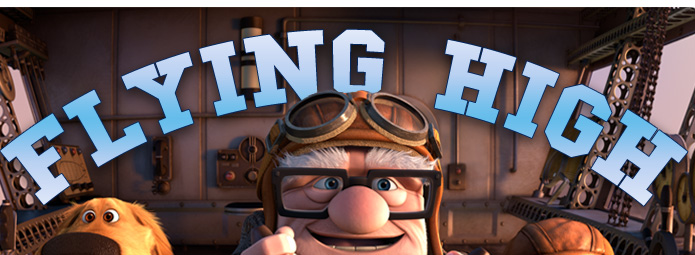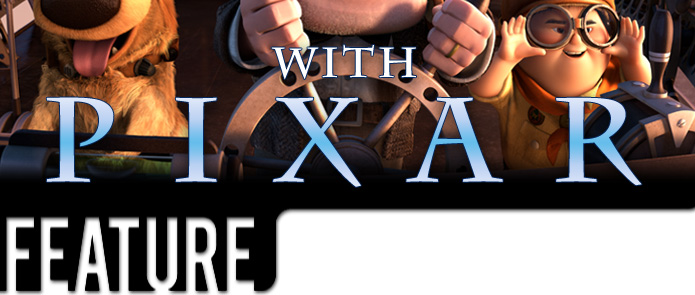

|

|

|

|

|

|
|
|
Flying High at Pixar
Co-director Bob Peterson and animators Aaron Hartline and Chris Chua discuss making the movie Up. By Jake Friedman Bob Peterson sits in an echo chamber of an office reminiscing about the movie Up. "It started with Pete Docter and me just knocking ideas around," he says. "First we thought about what type of character had never been done, and also what kind of character could give us an emotional journey that the audience would want to go on. We came up with the idea of an old man in an action adventure. Pete and I developed the project from the ground up." Pixar's film Up was released last May to critical acclaim, and features a curmudgeonly geriatric widower named Carl Fredricksen as the unlikely hero. After Carl attempts to fulfill a promise to his departed wife by ballooning their house to South America, he learns to let go of the past and to appreciate the adventure of new relationships. Peterson earned a co-director and writer credit after Docter's top-billed director credit for the film, which hit the stands on DVD and Blu-ray Nov. 10. Both products contain commentary from Docter and Peterson. Bonus features include alternate storyboards, a bonus short (Dug's Special Mission), and a documentary on a trip the top artists made to the mountainous South American landscape that inspired the film. You also get to see alternate versions of the film's climax, which equals a rare look into Pixar story-problem-solving. "I actually am a cartoonist at heart," says Peterson, who, with his storyboards, has climbed from Joe Ranft's story department on A Bug's Life to being an Oscar®-nominated screenwriter for Finding Nemo. "I did not have a traditional Cal Arts reel when I applied here. I had my college cartoon strip and a few computer graphics shorts I did in L.A. And I was dinged three times by Pixar. But, I happened to know a guy named Roger Gould who needed a third-string animator on a commercial, so in 1994 he asked me to come in." Peterson took a salary hit to work a freelance Pixar commercial job. "But once I found my niche, I worked really hard day and night to finally achieve a full time job." In addition, it was at a conference in the mid-80's that Peterson heard the mission of Pixar co-founder and creative steam engine John Lasseter. He was floored. "I can't stress enough how important it is to go to conferences and take part in social networking," he says. "Getting to know people in the industry is much easier now. You want to develop yourself as a person, too, so that people want to work with you. Life experiences come in handy to draw from in any creative endeavor. Also, when you are starting out it is important to do a lot of what you're interested in, and get plenty of feedback from the people around you. Aaron Hartline has been an animator at Pixar for two years. He's also an Animation Mentor Campus Mentor and teaches a Basic Foundation class at the online animation school. "I couldn't have hoped for a better experience with the director and the team," he says. "When the director is talking about the shot, I take a lot of notes. Usually it's a keyword or phrase that the director will mention while describing the shot, and sometimes it's a gesture or facial expression he does while acting it out. Taking that information back to my desk, I'll sketch out some poses on paper or simply turn on my computer and record myself acting out the shot. Rarely do I ever follow the drawings or video exactly, but it's a way to get the idea out quickly. Then, I seek out other animators and share my idea and, nine times out of ten, they add upon or come up with something even better." "First I get my assigned shots which can either be a continuous chunk in a sequence or separate shots within it," says animator Chris Chua. When not at Pixar, Chua also teaches Basic Foundations to Class 1 at Animation Mentor. "I'll watch the sequence first and then replay my shot(s) over and over in a loop. At this time, I'll be thinking about the character's state of mind and the acting that I'm envisioning for the shot. Sometimes it helps if I get up and physically act things out as well. If I'm still unclear about what I want to do, I'll go to the acting room and film my performance and use that to inspire and inform what I want out of my shot." "We spend a lot of time pretending we're the characters," says Peterson. (For the character of Carl) "We had special big pants made that the animators would wear and we spent a lot of time walking around with a cane and what it would feel like going over different terrain. I remember my grandfather used to fold his hands over his cane and not move a lot, and we talked a lot about that sort of graceful rigidity. So a lot of it is just great observation of how people move." Chua adds, "I thumbnail my poses, making sure to explore and push certain ideas. This is the time when I start to commit to my ideas before I dive into animating my shot. When I finally start to animate, I usually have my keys on clamped (stepped) mode. This is very important because I can concentrate on setting my keys on the same frame without the added pressure of dealing with the in-betweens just yet. I'll jump from key to key and add necessary breakdowns to describe arcs and paths of action, as well as figuring out the timing of how one pose will go into the next." "Opening up the shot," says Hartline, "I spend half the day getting everything clean and organized in the shot. After that, I do a rough pass of the lip-sync before I start blocking out the body – not because it's important to do the lip-sync first, but rather so I can hear the dialogue over and over again and to get familiar with the shot. For big, action shots and full body acting shots, I usually do step blocking. For close-up acting on the face, I usually go straight ahead and smooth it out." Hartline admits that his biggest weaknesses are walks and lip-syncs. "I could request not to do those kinds of shots, but then how would I get better? You have to keep trying and failing. Without failure, you never learn anything." "The big thing I'm struggling with and learning every day is story structure, which is a very difficult thing to master," says Peterson. That's where the collaborative process at Pixar comes in handy: Docter had graduated CalArts with student Oscar before being a leading animator at Pixar and directing 2001's Monsters Inc. "Pete comes from a background of animation and I come one of story," adds Peterson. "Each of us brings different sensibilities to the table. I love dialogue and Pete is amazing at finding great entertainment in situations. While we were writing together, we helped the other discover what the story structure needed to be. Also, when we got lost, our Brain Trust was there to put us back on track." "Pete Docter is all about the emotion of the shot," says Hartline. "He'll tell you where the character is coming from and what he is going through in your shot. Rarely does he give you specific acting notes. Pete is a very trusting director. As long you hit the emotion, he will let you bring your own ideas to the table." "It was very evident early on that he relished working with animators and he constantly encouraged us all to explore creative ways of handling the characters in the movie," says Chua. "Pete is also very down to earth and humble, giving Up its warm and intimate feel which you can see in every frame of the film."
Jake Friedman is a New York-based animator. Visit him at http://www.jakefriedman.net. |
|